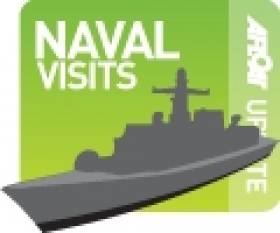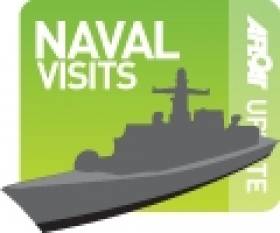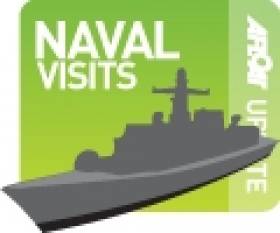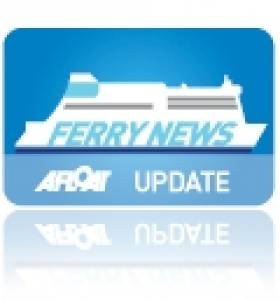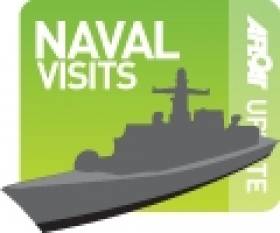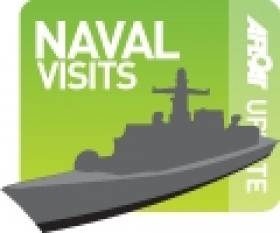Displaying items by tag: HMS Illustrious
#HMSillustrious - The Royal Navy’s former and final ‘Invincible’ aircraft carrier HMS Illustrious which made a rare call to Dublin in recent years departed UK waters for the last time yesterday bound for a Turkish shipbreakers yard, writes Jehan Ashmore.
HMS Illustrious was launched in 1978 but commissioning of the aircraft carrier notably took place after the Falklands War or 'conflict' with Argentina as it was also known. The carrier became synonymous given the vital role of the RAF Harrier Jump-Jet aircraft. In more recent years the aircraft-carrier was scaled down to that of only carrying helicopters.
The third of the ‘Invincible’ class carrier sailed from the UK premier naval base of Portsmouth bound for Falklands in the South Atlantic. Likewise a departure from the Hampshire port was repeated for the final time yesterday albeit under tow on a delivery voyage set for the Mediterranean Sea. A Turkish shipbreaker will dismantle the ship for recycling.
The veteran vessel of 22,000 gross tonnage had over a 32 year career taken part in global conflicts and humanitarian rescue missions. In doing so the ‘Lusty’ as she is referred by crew has clocked up 900,000 thousand miles until retired following decommissioning in 2014.
A pair of ‘Queen Elizabeth’ aircraft carriers are been built in Scotland with other yards in the UK contributing modular sections. Among them Babcock Marine & Technology, the north Devon shipbuilders of the Irish Naval Service OPV90 ‘Beckett’ /Playwright sisters. So far they total three ships with the commissioning naming ceremony of LE William Butler Yeats in Galway held in October.
HMS Illustrious follows the leadship class namesake and HMS Ark Royal which together were sold for scrap overseas. Despite an open competition held over a two year timeframe that sought to save the ship or retain part of the aircraft carrier for heritage purposes in the UK, such attempts to keep the ship in home waters failed.
The Ministry of Defence deemed proposals by some to convert the ship as a museum or hotel as too expensive.
Final ‘Invincible’ Aircraft-Carrier HMS Illustrious Retires
#HMSillustrious– HMS Illustrious (RO6), the Royal Navy's sole remaining 'Invincible' class aircraft-carrier was decommissioned in a ceremony at Portsmouth Naval Base yesterday, writes Jehan Ashmore.
She served for more than three-decades as the back-bone of the Royal Navy and in that timeframe she sailed 900,000 miles.
HMS Illustrious last month returned to her homeport of Portsmouth for her final time. Before she berthed in the Hampshire port, she met her successor at sea, HMS Ocean (L12).
As previously reported on Afloat.ie, HMS Ocean had gone for a £65m refit at Devonport Royal Dockyard. The major overhaul sees her take over duties of HMS Illustrious as the UK's on-call combat helicopter-carrier.
Launched in 1978 at Swan Hunter on the Tyne, the 22,000 tonnes HMS Illustrious would later be given her nickname 'Lusty' by her crew members. She made a farewell tour of UK ports last year, among them Liverpool. As the last of the 'Invincible' trio, she followed leadship HMS Invincible and Ark Royal.
The class were made famous for carrying 'Harrier' VSTOL jump jets that proved a vital role in the Falklands Conflict in 1982. In more recent years, the role of HMS Illustrious as an aircraft-carrier was scaled down to that of only carrying helicopters.
As previously reported on Afloat.ie, HMS Illustrious visited Dublin Port in April 2013, this rare call would be the last. Only months later, she undertook an emergency humanitarian relief mission after Typhoon Haiyan struck the Philippines in December.
Both HMS Invincible and HMS Ark Royal were scrapped, the manner in which they were allowed to be disposed by the UK Ministry of Defence has caused critism from the public and there are now calls to save the 'Lusty'.
In June of this year, HMS Illustrious berthed in Rosyth next to the newbuild HMS Queen Elizabeth, the first of a pair of 65,000 displacement tonnes 'QE' class aircraft-carriers. Leadship, HMS Queen Elizabeth was named at the Babcock Marine shipyard by Queen Elizabeth II.
HMS Illustrious Reaches Isolated Philippines Islands
#Philippines – According to the Royal Navy, HMS Illustrious (RO6) the helicopter-carrier as previously reported has arrived in the Philippines today to bring a further boost in the humanitarian relief effort.
The 22,500 tons 'Invincible' class carrier will take over from HMS Daring (D32) which has been distributing aid and assisting villagers in remote communities on islands to the north east of Panay for the past week.
Onboard the flight-deck of HMS Illustrious are seven helicopters which will play a pivotal role in carrying around 500 tonnes of UK Aid to communities.
The delivery of aid includes 12,500 blankets, 20,000 candles, 30,000 rice bags, 9,800 tins of sardines, 8100 tins of vegetables, 17,000 shelter kits, 1,000 jerry cans and 1900 water carriers.
The workload in transporting the aid quickly into remote areas will be carried out by three Sea King Mark 4s, one Merlin and three Army Lynx.
The carrier was around 6000 nautical miles away in the Horn of Africa on counter-piracy operations as part of the Royal Navy's Response Force Task Group when she was re-tasked with the humanitarian aid operation.
#Philippines – The Royal Navy's helicopter-carrier HMS Illustrious (R06) which visited Dublin Port in April is heading for the Philippines to bolster efforts to help those in the wake of Typhoon Haiyan.
UK Prime Minister David Cameron yesterday ordered that the former aircraft-carrier which was on a counter-piracy patrol off Somalia to break-off and make the 4,500-mile journey to the Far East.
HMS Illustrious has around nine days to reach the stricken nations central islands. She follows destroyer HMS Daring which is just around a day away from the worst-affected area and ready to begin her relief mission.
In addition Mr. Cameron has pledged £10m in aid and dispatching two RAF C17 Globemaster transporter aircraft which will also support the relief operation, codenamed Operation Patwi.
HMS Darling had departed Singapore on a mercy dash across the South China Sea and Pacific. The 8,000 tons destroyer was five months into a nine-month global deployment that included an international naval exercise Bersama Lima.
The Portsmouth-based Type 45 destroyer has a large flight deck to accommodate helicopters (up to the size of a Chinook), which will be vital for this latest disaster relief role. The destroyer's multi-purpose role demonstrates the global capability in providing humanitarian aid after natural disasters.
She is the first of the six Type 45 destroyers, each costing £1bn and they are the most advanced warships the Royal Navy has ever had built. She was launched at BAE Systems Scotstoun shipyard on the Clyde, one of three Scottish facilities to remain as centres of naval shipbuilding in the UK, following widespread cut to jobs.
#AircraftCarrier – During the rare visit of the Royal Navy's HMS Illustrious (R06) to Dublin Port (PHOTO's) at the weekend, the last serving 'Invincible' class aircraft-carrier was given a Gathering welcome with a showering of green light, writes Jehan Ashmore.
The 22,000 displacement tons former aircraft-carrier which currently serves in the role as a High Readiness Helicopter and Commando Carrier, had called to the capital having completed Exercise Joint Warrior, a multi-national event involving several navies, off the coast of Scotland.
The 35 year old vessel which berthed at Alexandra Basin, was floodlit in green (as it happens, aptly on her starboard side) from lamps laid alongside Ocean Pier.
The special lighting effects were created by the Worshipful Company of Lightmongers with whom 'Lusty' as she is affectionately known by her 700 crew have a close affiliation to.
Niall Gibbons, CEO Tourism Ireland, said: "We were delighted to welcome HMS Illustrious to Ireland and are sure that the sailors on board received a wonderful Irish welcome during their stay."
During her visit, two members of the Ship's Company, Able Seaman Andrew Liston, 25, from Chesterfield and Able Seaman Aaron Canwell, 31, from Wembley, were both awarded certificates of Irish Heritage for having family ties to the country.
Another highlight of their 'Gathering' visit was a performance by Irish group, Ragus, who transformed the ship's hangar into a stage filled with traditional Irish music and dance.
HMS Illustrious was launched in 1978 from Swan Hunter on the Tyne and for most of her career spanning more than three decades the 209m long vessel had on board the famous 'Harrier' VSTOL jump-jets aircraft.
The Portsmouth based vessel is one of four Royal Navy core amphibious vessels, however she is due to pay off in 2014 and in her place are a pair of Queen Elizabeth class 65,000 tons aircraft –carriers currently under construction.
Until these newbuilds are delivered, HMS Ocean (L12) a helicopter carrier of 21,500 tons which has called to Dublin Port on previous occasions, is to replace the Lusty after completion of a £65m refit at Devonport Royal Dockyard early next year.
Yesterday HMS Illustrious departed Dublin Port as did all the other visiting navies which took part in Exercise Joint Warrior, except for the French Navy's oil replenishment tanker Marne which made an exodus this afternoon.
Final Naval Visitor to Dock in Dublin Port
#NavalFlotilla – With the Royal Navy's HMS Illustrious (RO6) already docked in Dublin Port along with German and French naval vessels, the port is expecting a final member of the visiting European naval flotilla this afternoon, writes Jehan Ashmore.
Berthed near to HMS Illustrious are the German Navy's oil replenishment tanker FGS Rheon (A1443) and Sachsen class frigate FGS Hessen (F221). Also in port is the French Navy's Marne (A630) another replenishment oil tanker.
While offshore of Dublin Bay is the remaining vessel due to arrive, the Royal Netherlands Navy HNMLS Luymes (A803) a hydrographic research vessel. The 2,091 tonnes vessel has completed carrying out exercises off Scotland along with her European fleetmates.
Only HNMLS Luymes is to berth closer to the city-centre along Sir John Rogersons Quay, which requires a transit through the East-Link lift toll bridge this afternoon.
The Naval Service L.E. Emer (P21) is also to moor alongside the south quays though not till tomorrow morning.
#Aircraft-Carrier- The Royal Navy's HMS Illustrious (RO6) which is the High Readiness Helicopter and Commando Carrier made a rare visit to Dublin Port when the 22,000 tonnes former aircraft-carrier docked at noon today, writes Jehan Ashmore.
The last of the 'Invincible' class of aircraft-carriers commissioned for the Royal Navy is in the capital as part of an international naval flotilla which are arriving at various stages today, having just completed a major multi national warfare exercise off the coast of Scotland.
Captain Martin Connell, Commanding Officer said: "We are really delighted to be visiting Dublin, especially during the period of The Gathering."
To mark her visit to Ireland during the Gathering, HMS Illustrious will be floodlit in green. Captain Connell added "we have been kindly donated some high powered green lighting. We are all looking forward to seeing the end effect."
HMS Illustrious which otherwise is known affectionately by all aboard as 'Lusty' – which used to carry 'Harrier' VSTOL jump-jet aircraft is due to pay off after 32 years sterling service in 2014 to make way for the next-generation aircraft carriers.
As previously reported on Afloat.ie, on the other side of the Irish Sea, she made a call to Liverpool in February on what was likely to be her last call to that city as part of a farewell UK tour of ports.
As regards HMS Illustrious's last call to Dublin Port, this was back in 2005 where she docked along the south quays, whereas on this occasion she is moored in Alexandra Basin, facing opposite the Poolbeg Yacht & Boat Club marina in Ringsend.
She is to remain in the port over the weekend and depart on Monday.
Ferry Cruises to Mark HMS Illustrious Visit to Liverpool
#SightseeingCruise- Special river explorer cruises operated by Mersey Ferries are to run this weekend to mark the visit of HMS Illustrious (R06) to Liverpool.
Onboard the river cruises this weekend 16-17 February, between 11am and 4pm (including 4pm cruise), Blue Badge Guides will be giving passengers live commentaries about HMS Illustrious and the aviation history of the Royal Navy.
For further details visit: www.merseyferries.co.uk/content/Cruises/Cruisedates.aspx
Liverpool’s ‘Lusty’ Valentine Marks Changing Times for Aircraft-Carriers
#AircraftCarriers – The Royal Nay's last 'Invincible' aircraft carrier, HMS Illustrious (R06) affectionately known by her crew as 'Lusty', which these days serves as a helicopter commando-carrier, docked on St. Valentine's Day at Liverpool Cruise Terminal, writes Jehan Ashmore.
As previously reported, during her five-day city courtesy call, she is to be open to the public this weekend. The call to Merseyside could be her last as the 22,000 displacement tonnes vessel is due to pay off in early 2014. She was launched in 1978 from Swan Hunter on the Tyne and over the next 32 years the 209m long vessel has served an illustrious career including her role in carrying 'Harrier' VSTOL jump jets.
The Portsmouth based HMS Illustrious is one of four Royal Navy core amphibious vessels, and in her place are a pair of Queen Elizabeth class 65,000 displacement tonnes aircraft –carriers currently under construction. However until delivered, HMS Ocean (L12) a helicopter carrier of 21,500 tonnes will replace Illustrious, after completion of a £65m refit at Devonport Royal Dockyard early next year.
Former Aircraft Carrier HMS ‘Lusty’ Open to Public Following Valentine Call
#AircraftCarrier- HMS Illustrious (R06) the Royal Navy's helicopter commando carrier is due to arrive in Liverpool on St. Valentine's Day and be open to the public next weekend (16-17 February), as part of a five-day call, writes Jehan Ashmore.
For more than three decades the former aircraft-carrier (equipped with Harrier jump-jets) has served the Royal Navy, however she is to pay-off in 2014, to make way for next generation aircraft-carriers.
Affectionately known as 'Lusty' to her crew, she is due berth alongside Liverpool Cruise Liner Terminal tomorrow at around 2pm, opposite the famous Liverpool waterfront skyline. There will be free public tours during Saturday and Sunday (10am – 4pm) noting the latest time to board is 3pm.
She forms as one of four core ships of the Royal Navy's amphibious fleet, they are the helicopter carriers HMS Ocean and assault ships HMS Albion and Bulwark, the latter is the flagship.
HMS Illustrious current role is as a High Readiness Helicopter and Commando Carrier and she is the last of the 'Invincible' class aircraft carriers commissioned for the Royal Navy during the 1970's.
As previously mentioned, the class were of course equipped with the revolutionary 'Harrier II' jump-jet VSTOL aircraft built by British Aerospace/McDonnell Douglas for the RAF, until these aircraft were retired in 2010. These days she conveys a range of helicopters, Merlin, Sea King, Apaches and Lynx for the Royal Marine Commandos.
Her sisters, the decommissioned leadship HMS Invincible (RO5) was scrapped in 2005 and HMS Ark Royal (R07), the final of the class launched in 1981 made a farewell tour around Britain in 2011. Last year it was announced that she too would be scrapped.





























